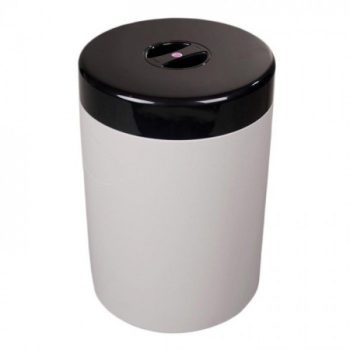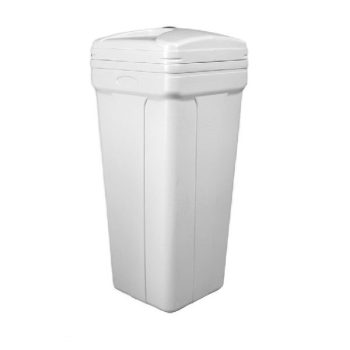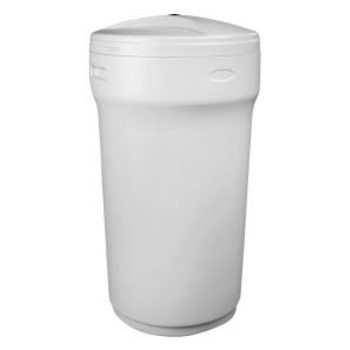Salt tanks for softeners
Tank for regenerating solution (35, 75, 100, 150, 200, 300, 500, 800 liters) is a part of water treatment and filtration plants, i.e. those filters that require salt or other chemical substance to restore filtering properties.
The solution with such substance - regenerant is prepared and stored (until the next regeneration) in a special container,
which for simplicity is called "tank".
The tank can be of different shape (for example, barrel-shaped, as shown in the picture on the left, or of square cross-section) of size and capacity, depending on the type of regenerant (chemical substance used for regeneration) and performance of the filter with which it will be used.
So, the tank is a kind of container [1] (usually plastic) with a lid [2]. The tank may contain a special mesh [3], on which the regenerant [7] will be poured. Strictly speaking, it is possible to do without this grid and there are many tank models where the grid is not used.
The most important assembly is the shaft [4] - a plastic pipe, inside of which the suction system is mounted, which includes a float locking valve [5] and a ball check valve [6] (air-check valve). The suction system is connected to the filter control unit via a connection [9].
The overflow connection [10] is installed in case of failure of all water quantity control systems in the tank and should ideally be connected to the drain line.
own enterprise
customized solutions
operational experience
and installation
The system operates as follows:
1) Start of operation
A certain amount of water [8] is fed into the tank from the filter (in some models, the first filling of water has to be done manually). A chemical regenerant [7] is then poured into the tank, e.g. tableted table salt for ion exchange softeners or potassium permanganate ("manganese") for oxidizing de-ironing filters. The amount of water is regulated either by adjusting the float valve [5] or by the automatic filter control unit (in this case the float valve serves as an additional protection against overflow) and depends on the type of filter and its size (capacity), but always a few centimeters above the level of the mesh [3], (if there is one).
It is very important that the tank for the regeneration solution is filled with a certain amount of water, not "as God would have it". For example, to regenerate 1 liter of resin in an ion exchange softener requires quite a certain amount of table salt (NaCl). In turn, the table salt is also dissolved in water in certain quantities (solubility limit of about 300 g/l). Thus, the amount of water is selected in which the required amount of table salt will dissolve for the complete regeneration of the filter-softener. If the water will be less, it will dissolve less salt and ion exchange resin will not regenerate sufficiently its ion exchange capacity - the efficiency of softening and water purification will be reduced. If there is more water, the resin will be regenerated even better, but at the same time salt consumption for each regeneration will increase and operating costs for maintenance of the water treatment system will increase.
It is also necessary that sufficient time elapses between regenerations to allow a concentrated regenerant solution to form in the tank. From this point of view it seems to be more rational to use the same salt not in the form of tablets, but ordinary salt in bulk. And it will dissolve faster and be cheaper. However, it is not by chance that salt is required in pressed form (it can be not only tablets, but also salt briquettes in the form of "pads" or capsules and simply pressed and then pounded into pieces of a few centimeters (like rubble) table salt). The point is that salt in placer form does not dissolve in water instantly, but very quickly molds into a monolithic lump. Such a lump will not only have a surface area much smaller than the same weight of salt in tablets, and therefore will be much slower to dissolve. It can "grow" around the shaft [4] with the suction system and thus completely block the filter regeneration system, which will inevitably lead to its failure.
2) Regeneration
During the regeneration cycle, the regeneration solution from the tank begins to flow through the suction system to the filter control unit. There, the regeneration solution is diluted with water in a certain proportion and is further utilized in the chemical regeneration process of the filter media used in this type of backfill filter.
As the regeneration solution is drawn in, the level in the tank begins to drop. This occurs until the ball shut-off valve [6] is triggered, i.e. the ball sits tightly in the seat and blocks the flow.
3) Filling with water
In this cycle, after the filter regeneration is complete, water from the filter control unit begins to be pumped into the tank. The water enters through the same suction line, only now "in the opposite direction" - through the connection [9] and the shut-off valve [6]. The water supply is stopped either by the command of the filter control unit or by the float valve [5], which, having floated to a certain level, cuts off the water supply to the tank. Over time, the required amount of salt will dissolve again in this water and the process will be repeated during the next regeneration.
This system is very simple and reliable. It is only necessary to remember to keep a reserve of regenerant in the tank. At the same time, there is no need to be afraid of "overfilling". You can pour it even to the very edge of the tank - anyway, it will not dissolve more than necessary. However, the level of regenerant should be periodically checked. The criterion is simple - there should always be dry regenerant at the top.
Dimensions of salt tanks
Name Diameter, mm Height, mm Name Diameter, mm Height, mm
Salt tank 35l (rectangular) 310 440 Salt tank 150l (round) 540 780
Salt tank 75L (rectangular) 310 890 Salt tank 200L (round) 540 1020
Salt tank 100l (round) 470 650 Salt tank 300l (round) 700 1070









